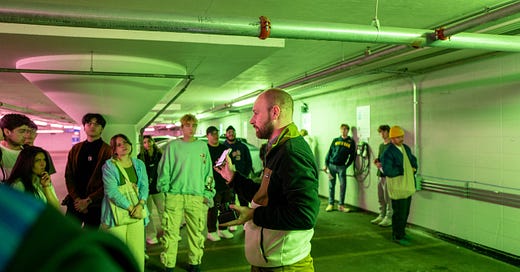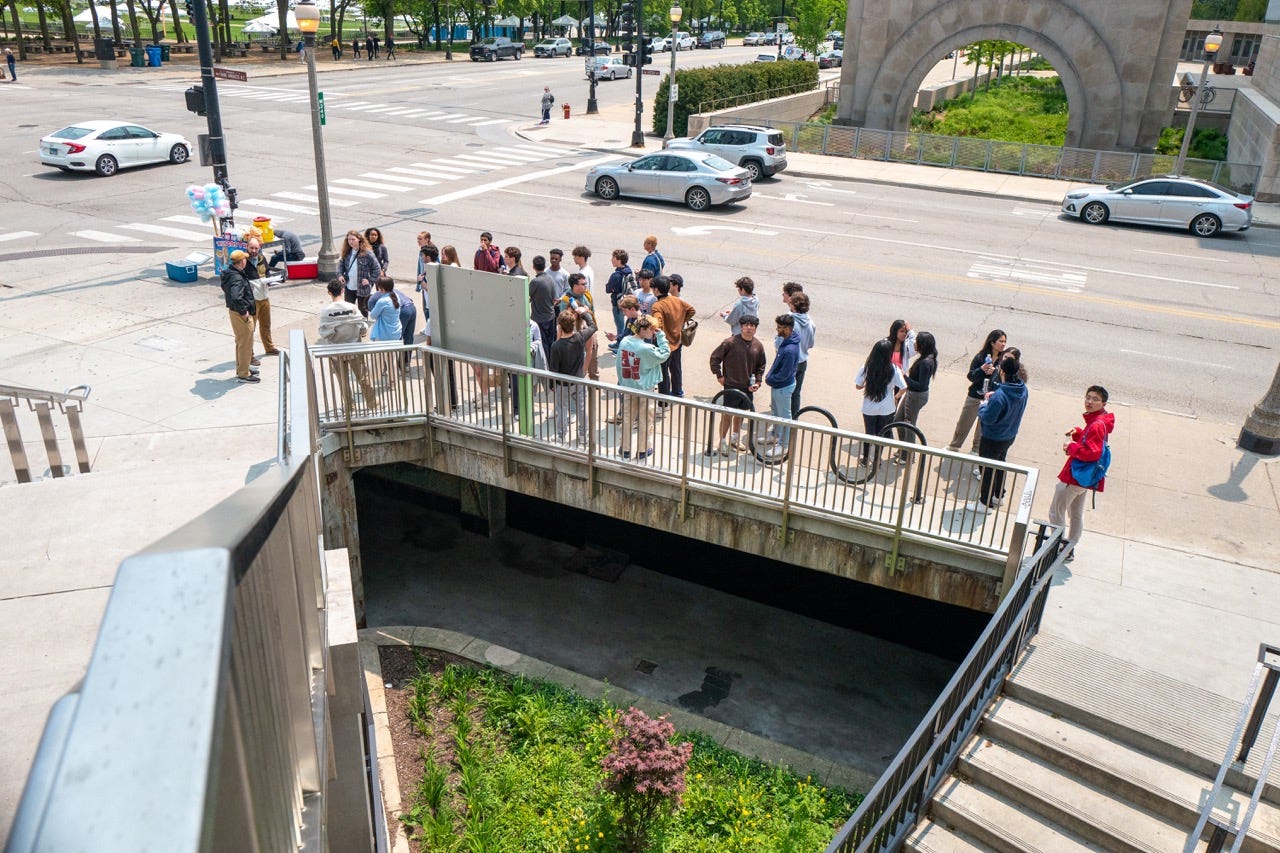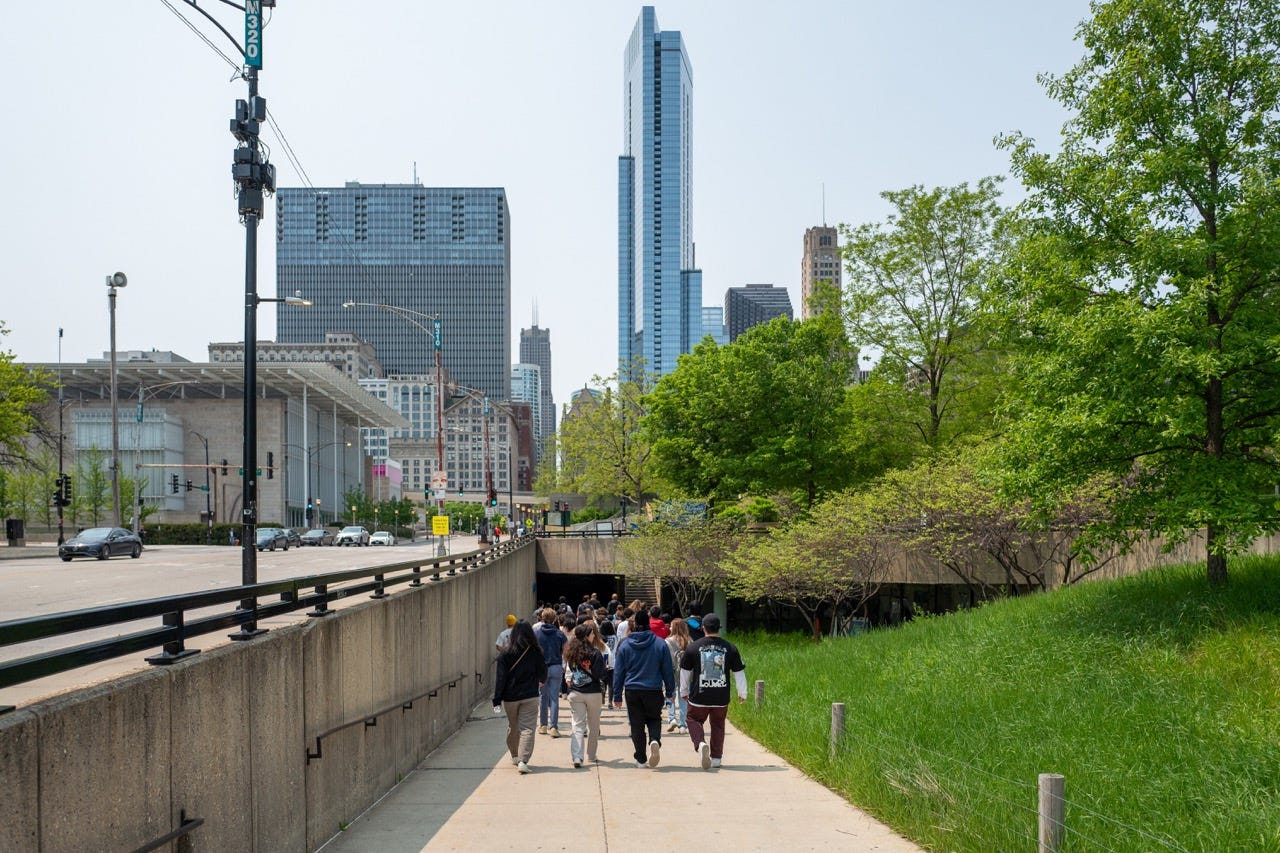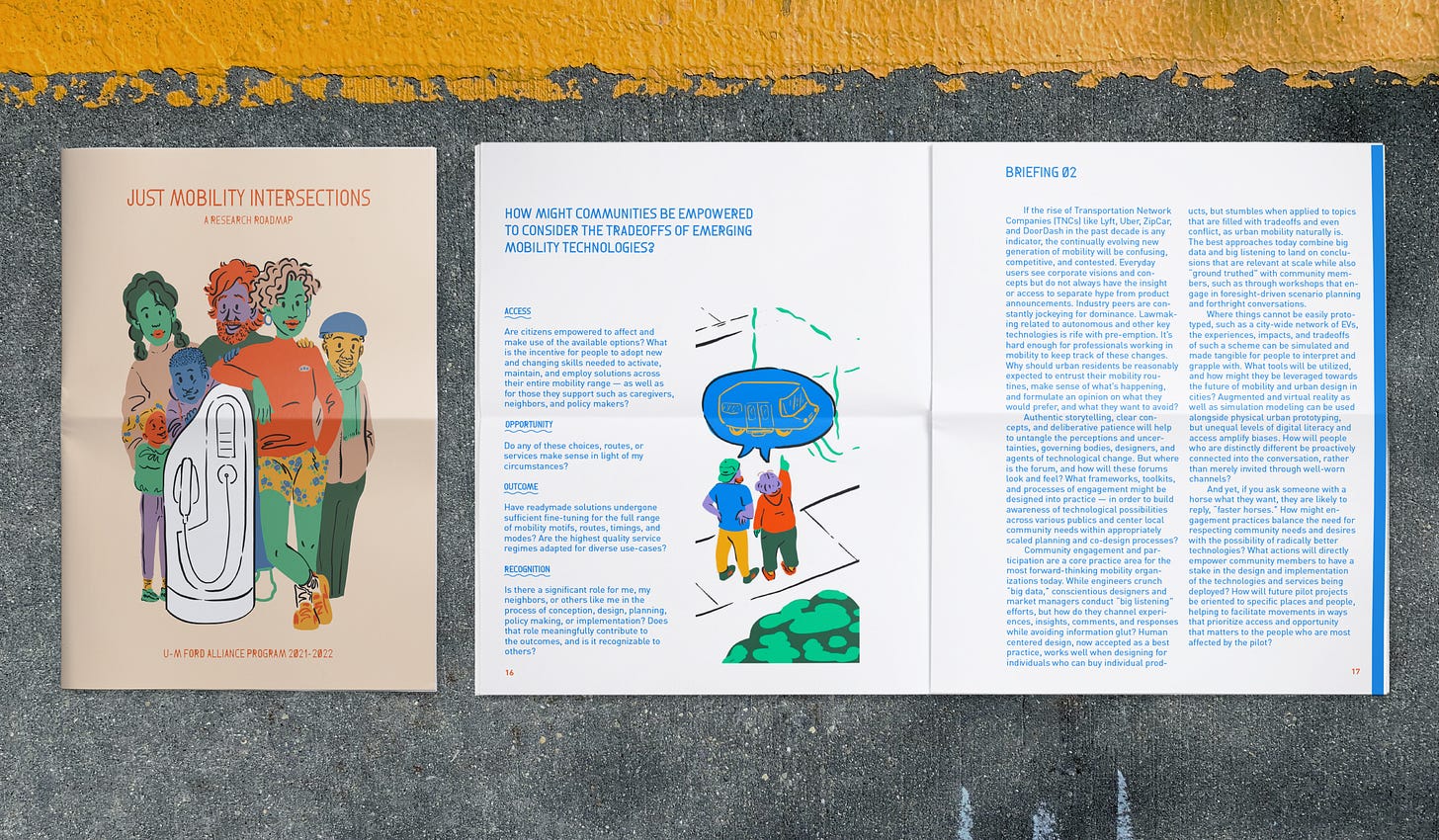Urban Technology at University of Michigan week 146
Chicago without Cars? + sharing a report on Mobility Justice
This week we're reporting from the Windy City, our second stop on the Urban Technology Cities Intensive, where we've been asking the question, "what would Chicago be like without cars?"

At the end of our third busy day here, the teaching team crumpled into sofas at a cafe and processed what we and the urban technology students had seen. Here's the riddle I asked them: if you took all of the cars in Chicago and rolled them into a giant katamari, how big would it be?
The answer to that, more about our trip, and a little about the urban tech dimensions of mobility justice after the jump.
💬 Hello! This is the newsletter of the Urban Technology program at University of Michigan, in which we explore the ways that data, connectivity, computation, and automation can be harnessed to nurture and improve human life in cities. If you’re new here, try this short video of current students describing urban technology in their own words.
⚡️ Visiting Millenium Garage
All of the cars in Chicago smushed into a giant ball would be approximately 600 feet in diameter, or about the same height as the One Prudential Plaza building that sits on the northern edge of Millennium Park. Here’s a photographic representation:

So what does a 600ft sphere of vehicles mean? If you're an urbanist, you probably love to hate on cars and that orb might look like a wrecking ball—an emblem of how automobility destroyed the fabric of American towns and cities. But if you hail from outer suburbs or rural hinterlands, the giant ball of cars might look instead like a monument to the freedom and that your vehicle grants you. America's vast and diverse geography makes hand wringing difficult. It's a place where politically viable answers most often involve the word "and." Because of the regional structure and the sheer scale of the United States, cars aren’t likely to disappear from cities in some kind of automotive rapture, but even incremental changes to the relationship between cars and cities can add up to significant and positive outcomes.
When we were here a year ago a theme of the trip was achieving equality of mobility choice, and that theme was echoed again this week. The both/and reality of urban mobility came to life during our time visiting and learning from folks at the Active Transportation Alliance, Chicago Metropolitan Agency for Planning, Center for Neighborhood Technology, and Shared Use Mobility Center. Across this plurality of visits we sharpened our eyes to see cars in their outsized presence in Chicago today while strengthening our muscles to imagine a Chicago tomorrow where non-motorized, shared, active transportation methods are safer and more attractive.
Here’s an example. On Wednesday we met Tom McCoy of the Civic Infrastructure Collaborative at the Millennium Garage to see how ‘CINCO’ is slowly but surely reinventing a legacy parking structure. Two floors below the beauty of the park with its incredible sculptures and gardens, Tom showed us a handful of improvements: scooters for last mile connectivity. EV charging. Local connectivity that makes phones work deep in a concrete bunker (a necessity if you want parkers to be able to use the app that initializes charging, for instance).

The deck was built over several decades, and its design is standard issue: concrete, underground, paint on the ground, cars in orderly rows. The scale, however, is nearly unfathomable with more than 9,000 parking spots. Even this card-carrying walkability advocate has to admit that the expanse of the subterranean space is sublime (side note: it would be even more incredible as an indoor farm with arugula stretching to the hypogeal horizon).
Tom and his colleagues at CINCO are collaborating with Argonne National Laboratory to reinvent this parking land ship into the Midwest’s largest public electric vehicle charging hub. The idea is that if they can get more people spending less time in cars, reduce the number of internal combustion engines spewing off carbon, and increase the number of people living active lifestyles, then this hub becomes a model that could be replicated elsewhere in Chicago, and other cities to boot. The technologies in play are humble, but that’s the point. Not every urban tech play is powered by machine learning and robots. The starting point for cities is incredibly offline, non-automated, and entrenched. The secret to urban tech is that only half of it is the tech part, the other half of the work is to make tech urban and literally “civilized”—shared, public, a fixture of the polis. That often calls for social innovation.
In the garage, as much as we nerded out about step down transformers and clocked kilowatt hours, we also paid close attention to the fact that the 100 chargers in Millennium Garage are bathed in a green glow signifying clearly that the electric future is here and not there, in the distance, where the lights are a different color. In that sense, wayfinding is as much an invitation as it is a navigational aid. In Detroit community organizers often repeat the phrase, “you can’t be what you cannot see” to describe the importance of exposing students to career opportunities and role models. Not a bad way to describe the social innovation required to make urban technology normal.
⚖️ Urban Technology and Mobility Justice
On the topic of mobility, optionality, and how cities proactively change the status quo, it’s worth noting that, of course, everyone does not have the same degree of access to venues where decisions are made that shape the “choice architecture” of urban mobility, which is a fancy way of describing the transportation options available to a citizen at any given time and the incentives or disincentives that inform their decisions.
Technologies such as AR/VR should be utilized along with good old fashioned service design to multiply and enhance the ways that city residents are invited into decision making about mobility (and much else) with an eye on expanding access, opportunity, outcomes, and recognition for America’s most marginalized communities.
In 2021 I worked with Taubman colleagues Gabriel Harp, Geoffrey Thün, Kathy Velikov, and Craig Wilkins; illustrator Martyna Alexander; and a cast of Ford employees who joined a series of workshops to explore this topic for Ford through a small research grant. The result was “Just Mobility Intersections,” a set of “micro briefings” that do nothing more than tee up future potential areas of research in mobility justice. Drawing on the work of folks like Untokening, Mimi Sheller, and Karel Martens, we sketched out half a dozen broad questions where mobility justice implicates urban design & technology.
The full report can be downloaded here as a PDF, and below is an excerpt of one of the briefings that has strong urban technology dimensions—it’s about the technologies of participation and decision making.
How might communities be empowered to consider the tradeoffs of emerging mobility technologies?
If the rise of Transportation Network Companies (TNCs) like Lyft, Uber, ZipCar, and DoorDash in the past decade is any indicator, the continual evolution of mobility will be confusing, competitive, and contested. Everyday users see corporate visions and concepts but do not always have the insight or access to separate hype from product announcements. Industry peers are constantly jockeying for dominance. Lawmaking related to autonomous and other key technologies is rife with pre-emption. It’s hard enough for professionals working in mobility to keep track of these changes; why should urban residents be reasonably expected to make sense of what’s happening, and formulate an opinion on what they would prefer—or what they want to avoid—without more effort applied to creating contexts for shared deliberation?
Authentic storytelling, clear concepts, and deliberative patience will help to untangle the perceptions and uncertainties attached to governing bodies, designers, and agents of technological change. But where is the appropriate forum, and how will these forums look and feel? What frameworks, toolkits, and processes of engagement might be designed to build awareness of technological possibilities across various publics and, simultaneously, center local community needs within right-sized planning and co-design processes?
Community engagement and participation are core practice areas for the most forward-thinking mobility organizations today. While engineers crunch “big data,” conscientious designers and market managers conduct “big listening” efforts, but how do they channel experiences, insights, comments, and responses while avoiding information glut? Human centered design, now accepted as a best practice, works well when designing for individuals who can buy individual products, but stumbles when applied to topics that are filled with tradeoffs and even conflict, as urban mobility naturally is. The best approaches today combine big data and big listening to land on conclusions that are relevant at scale while also “ground truthed” with community members. In this vein, workshops that engage in scenario planning or gameplay are promising.
Where things cannot be easily prototyped, such as a city-wide network of EVs, the experiences, impacts, and tradeoffs of such a scheme can be simulated and made tangible for people to interpret and grapple with. What tools will be utilized, and how might they be leveraged towards the future of mobility and urban design in cities? Augmented and virtual reality as well as simulation modeling can be used alongside physical urban prototyping, but unequal levels of digital literacy and access risk amplifying biases. How will people be proactively initiated into the conversation, rather than merely invited through well-worn channels?
And yet, if you ask someone with a horse what they want, they may well reply, “faster horses.” How might engagement practices balance the need for respecting current community needs and desires with the possibility of dreaming up radically better technologies? What actions will directly empower community members to have a stake in the design and implementation of the technologies and services being deployed? How will future pilot projects be oriented to specific places and people, helping to facilitate movements in ways that prioritize access and opportunity that matters to the people who are most affected by the pilot?
Like I said, no answers here, only questions. But if you’re into that sort of thing there are five more micro briefings awaiting you in the download. And if you’re really into this, join us in the urban technology program and projects like this will be your homework.
These weeks: Making notes about how to travel with 40 students, have a good time, learn a lot, and make it home safely. That’s more than enough! 🏃









